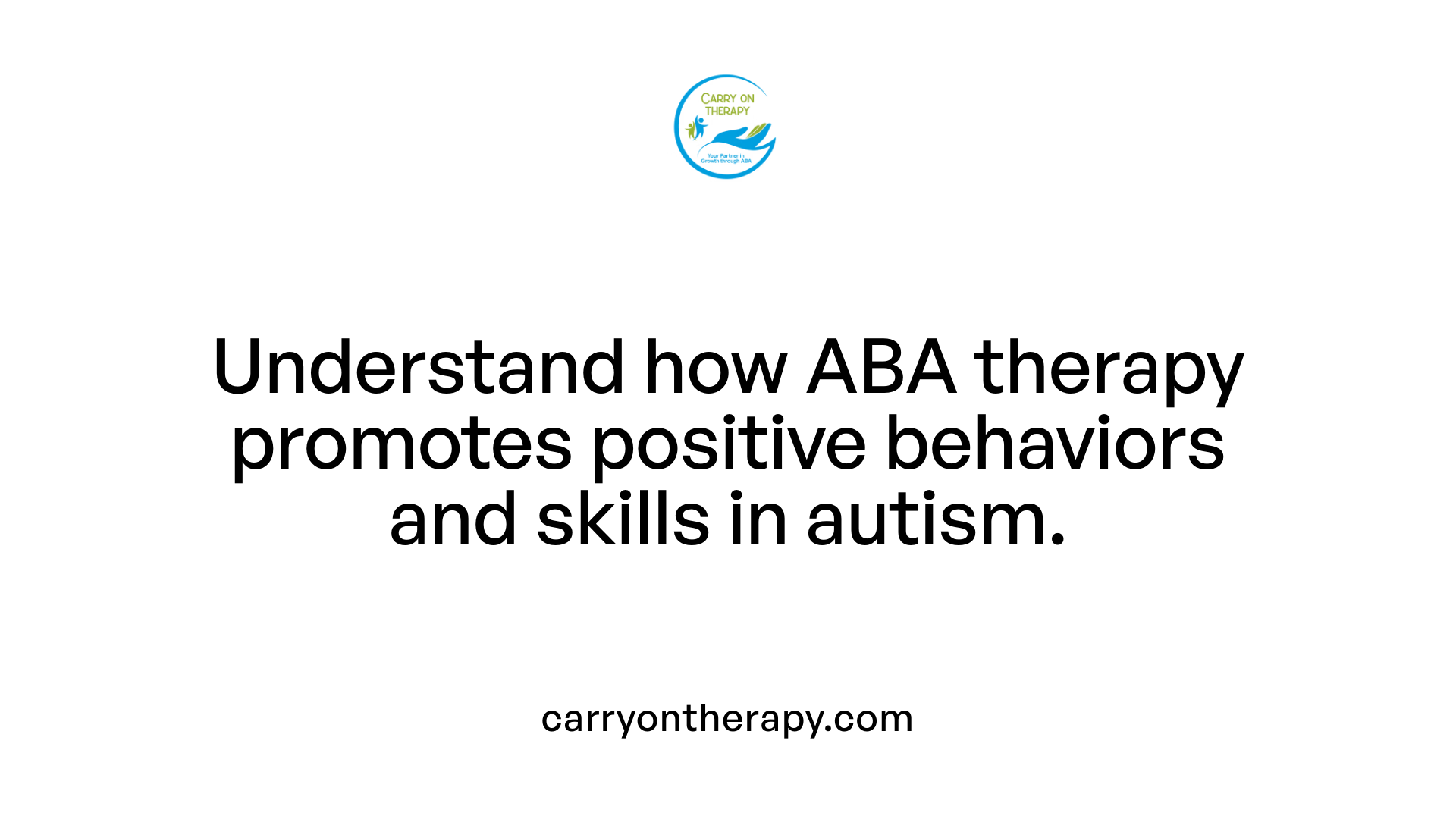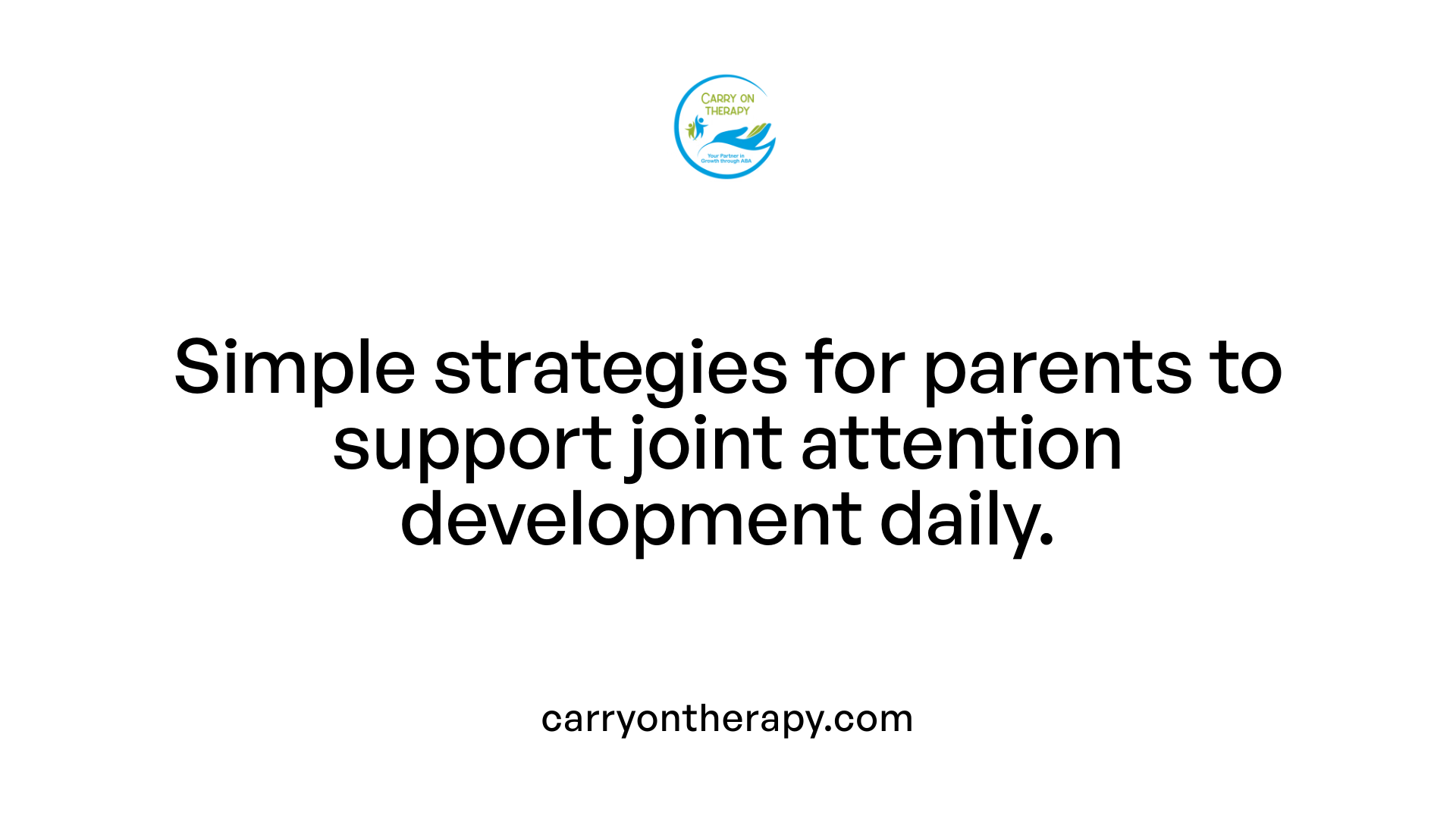ABA Therapy for Joint Attention
Unlocking Social Connections: The Role of ABA in Enhancing Joint Attention

Understanding the Critical Link Between Joint Attention and Autism Therapy
Joint attention—the shared focus of two individuals on an object or event—is a foundational social communication skill that is often delayed or impaired in children with autism spectrum disorder (ASD). Applied Behavior Analysis (ABA) therapy, a scientifically validated approach to behavior modification, has shown promising results in developing joint attention skills, which are essential for language development and social interaction. This article explores how ABA therapy targets joint attention, the evidence supporting its effectiveness, and the role of qualified professionals in delivering these interventions.
What is ABA Therapy and How Does It Support Children with Autism?

Definition of ABA therapy
Applied Behavior Analysis (ABA) therapy is a scientifically grounded method that focuses on understanding and changing behavior through learning principles. It is widely used to assist children with autism by increasing positive behaviors like communication and social skills while reducing challenging ones.
Principles of ABA
ABA applies techniques such as prompting, modeling, and positive reinforcement. Prompting guides children to perform behaviors, modeling demonstrates desired actions for imitation, and reinforcement rewards successful behaviors to encourage repetition.
Goals of ABA in autism treatment
The main goals are to help children develop crucial skills for daily life, including social interaction, language, and self-care, thereby promoting independence and improved quality of life.
Specific techniques used in ABA to improve joint attention
To develop joint attention – the ability to share focus on objects or events – ABA therapists use prompting to guide children in behaviors like eye contact and pointing. Modeling shows these behaviors clearly. Positive reinforcement then rewards the child for engaging in joint attention, strengthening these important early social communication skills.
Importance of early intervention
Starting ABA therapy early can lead to significant improvements in language and social skills. Early focus on joint attention is especially important as it lays the foundation for successful communication and social interaction later in life.
The Importance of Joint Attention in Autism Development

What Is Joint Attention and What Are Examples of Joint Attention Behaviors?
Joint attention (JA) is the shared focus of two people on an object or event, a fundamental social communication skill. It is achieved through behaviors such as eye gaze, pointing, gestures, vocalizations, and following or initiating bids to share attention. For example, a child might look at a toy, then back at a parent to share interest, or respond when someone points to an object.
How Does Joint Attention Influence Language and Social Development?
Joint attention lays the groundwork for language acquisition by helping children link words with objects or events. It also contributes to social interaction skills, enabling children to engage with others in meaningful ways. Without joint attention, children might struggle to understand or participate in communication and social play.
What Joint Attention Challenges Are Common in Children with Autism?
Children with autism often display differences or delays in joint attention behaviors. They might avoid eye contact, not respond to pointing or gestures, or have difficulty initiating shared attention. Such deficits affect their ability to communicate effectively and engage socially.
Why Is Joint Attention a Focus in Autism Therapies?
Due to its critical role in social communication and language development, joint attention is a primary target in autism interventions. Therapies use strategies like prompting, modeling, and positive reinforcement to teach joint attention skills. Improving these behaviors can lead to short-term gains in social communication and potentially support long-term language development.
These combined insights underline that developing joint attention not only enhances social and language outcomes but also fosters meaningful interpersonal connections essential for children with autism.
How ABA Therapy Techniques Target Joint Attention Skills
What ABA Strategies Are Used to Enhance Joint Attention?
Applied Behavior Analysis (ABA) therapy employs a combination of prompting, modeling, and positive reinforcement to develop joint attention skills in children with autism.
Prompting helps guide children to perform joint attention behaviors, like following eye gaze or gestures, with supports gradually faded as skills improve.
Modeling involves therapists or caregivers demonstrating joint attention actions such as pointing or maintaining eye contact for children to imitate.
Positive reinforcement rewards successful joint attention attempts, often through verbal praise or access to favorite items, to encourage the repetition and strengthening of these social skills.
What Types of Joint Attention Behaviors Are Taught?
ABA programs teach children to both respond to and initiate joint attention cues. For example:
- Responding to bids like someone pointing to an object
- Initiating eye contact to share interest
- Using gestures or vocalizations to draw attention
These foundational behaviors support later social communication and language development.
How Are Preferred Toys and Rewards Used?
Therapists frequently use preferred toys as reinforcers to motivate children. In the study by Whalen and Schreibman (2003), access to a favorite toy followed a child successfully responding to or initiating joint attention. This tangible reward helps reinforce the desired behavior, making therapy sessions engaging and effective.
What Challenges and Outcomes Have Studies Identified?
Whalen and Schreibman's research demonstrated that four out of five preschool children learned joint attention behaviors and could apply them across settings. However, initiating joint attention was less consistently maintained over time.
Challenges noted include the artificial nature of reinforcement environments compared to typical social situations and a narrow focus mainly on eye gaze behaviors. The study also suggested parent training could be critical to help sustain these skills outside therapy.
Overall, ABA therapy's targeted use of prompting, modeling, and reinforcement shows promising success rates in improving joint attention, a crucial early skill for children with autism.
Structuring an ABA Therapy Program Focused on Joint Attention

Assessment and Individualized Program Planning
An ABA therapy program for a child with autism typically starts with a detailed assessment to identify the child’s specific strengths and needs, with a focus on joint attention skills. This initial evaluation guides the development of a personalized intervention plan aimed at improving social communication and related behaviors.
Setting Specific Goals for Joint Attention Skills
Therapists set clear, measurable goals for joint attention, such as responding to eye gaze or initiating shared focus through gestures. These objectives are designed to be achievable and build progressively to support language and social development.
Session Planning Including Discrete Trial Training and Naturalistic Teaching
Sessions combine structured discrete trial training (DTT), where joint attention behaviors are taught in a step-by-step format with prompts and reinforcement, and naturalistic teaching that encourages joint attention during play and everyday activities. Techniques such as modeling, prompting, and positive reinforcement are used to encourage skills like pointing, eye contact, and shared focus.
Role of Data Collection and Progress Monitoring
Consistent data collection throughout therapy sessions helps track the child’s progress and informs necessary adjustments. Monitoring ensures that gains in joint attention are maintained and generalized to different settings, such as home or school.
Incorporating Family Involvement for Skill Generalization
Family participation is vital to generalize joint attention skills beyond therapy. ABA programs often include parent training to teach strategies like responding to the child’s interests and using gestures paired with words, enabling families to support skill development during daily routines and play.
| Component | Description | Purpose |
|---|---|---|
| Assessment | Evaluating individual strengths and challenges | Tailor interventions to the child’s needs |
| Goal Setting | Defining specific joint attention objectives | Guide therapy and measure progress |
| Session Planning | Combining discrete trial training and naturalistic teaching | Teach skills systematically and naturally |
| Data Collection | Recording behavior and progress | Inform adjustments and ensure skill retention |
| Family Involvement | Training caregivers to support skills at home | Promote generalization and consistency across settings |
Who Provides ABA Therapy? Qualifications and Roles

Who Provides Applied Behavior Analysis (ABA) Therapy and What Qualifications Should They Have?
ABA therapy is delivered by a range of professionals trained in behavioral interventions, including Board Certified Behavior Analysts (BCBAs), Board Certified Assistant Behavior Analysts (BCaBAs), and Registered Behavior Technicians (RBTs). These providers must hold appropriate certifications demonstrating their knowledge and expertise in ABA principles and techniques tailored for individuals with autism spectrum disorder (ASD).
Licensed professionals such as psychologists, developmental pediatricians, and psychiatrists play a crucial role in diagnosing ASD. Their assessments are necessary to establish medical necessity, which is often required to qualify a child for ABA services.
Certification and Training Requirements
- BCBA: Requires a master’s degree or higher, completion of specific ABA coursework, supervised practical experience, and passing a rigorous certification exam.
- BCaBA: Functions under BCBA supervision with similar but less extensive training.
- RBT: Provides one-on-one therapy under BCBA or BCaBA supervision with focused training on implementing treatment plans.
Roles in Diagnosis and Treatment Planning
Licensed clinicians are responsible for formal diagnosis and developing individualized treatment plans that ABA providers then implement. This collaboration ensures interventions are tailored, relevant, and effective.
Importance of Verifying Qualifications and Insurance Coverage
Families should verify provider credentials and confirm state licensure where applicable, as registration and insurance policies vary by region. Insurance coverage often requires providers to be in-network and mandates documentation of medical necessity.
Choosing qualified ABA therapists and ensuring proper diagnoses and insurance approval are essential steps for effective, personalized care that supports the child’s developmental progress.
Evidence Supporting ABA Interventions for Joint Attention in Autism
What evidence supports the effectiveness of Applied Behavior Analysis (ABA) for autism?
Applied Behavior Analysis (ABA) has been extensively researched and is widely recognized as an effective intervention for children with autism, especially for improving communication and social skills. Research studies, including randomized controlled trials (RCTs), have demonstrated that ABA techniques such as prompting, modeling, and positive reinforcement can significantly increase joint attention skills—a foundational social communication ability often delayed in children with autism.
For example, the study by Whalen and Schreibman (2003) employed ABA procedures to teach joint attention behaviors to preschool children with autism. Most participants learned to both respond to and initiate joint attention bids, and they were able to generalize these skills beyond the treatment setting. This highlights ABA’s practical impact on social communication.
How have controlled trials and meta-analyses evaluated ABA's efficacy in joint attention?
RCTs and experimental studies have generally reported short-term gains in social communication following interventions emphasizing joint attention. Interventions like JASPER (Joint Attention and Symbolic Play/Engagement and Regulation Treatment), which combine behavioral and developmental methods, show particularly promising results. These combined approaches include direct skill targeting, behavior modeling, shaping, and contingency-based responses, enhancing both joint attention and related communication abilities.
Moreover, caregiver-mediated models using ABA principles have been effective, especially when the intervention is implemented with high fidelity and frequent sessions. Meta-analyses affirm these positive outcomes, reinforcing ABA as a robust treatment choice.
What specific improvements are observed through ABA for joint attention and communication?
Children receiving ABA interventions typically demonstrate:
- Increased frequency and quality of eye gaze and gesture use.
- Improved ability to initiate and respond to joint attention bids.
- Enhanced language development over time, as joint attention facilitates understanding and use of words.
- Better sharing of interests and experiences during play and social interaction.
However, some studies note variability in the durability of initiating joint attention behaviors, suggesting ongoing support may be necessary.
Are combined developmental and behavioral approaches more effective?
Yes, interventions that blend developmental frameworks with ABA techniques tend to yield more substantial gains. These approaches consider the child's developmental readiness and use modeling and shaping alongside structured ABA strategies. By integrating contingency management with naturalistic social interactions, these methods optimize learning and generalization.
What are some limitations and considerations in ABA joint attention research?
Despite positive findings, some limitations exist:
- Many studies occur in controlled or laboratory environments, which may differ from natural settings.
- Reinforcement methods used may not fully mirror typical developmental contexts.
- Some interventions focus narrowly on eye gaze and initiating/responding behaviors, potentially overlooking wider joint attention skills.
- Not all increases in parental responsiveness immediately translate to child skill improvements.
Ongoing research aims to refine intervention delivery models and tailor strategies based on individual child characteristics for better long-term outcomes.
| Aspect | Details | Notes |
|---|---|---|
| Research Methods | RCTs, experimental studies, meta-analyses | Show consistent short-term joint attention gains |
| Intervention Examples | JASPER, Parent-Mediated Communication-Focused Treatment (PACT) | Combined approaches generally more effective |
| ABA Techniques | Prompting, modeling, positive reinforcement | Effective in teaching responding and initiating joint attention |
| Limitations | Artificial settings, narrow skill focus, variable skill retention | Caregiver training and naturalistic practice important for generalization |
ABA interventions provide a solid evidence-backed method for developing joint attention skills in children with autism, laying a foundation for improved communication and social engagement.
Collaborative Approaches: Therapists and Caregivers Enhancing Joint Attention
How Can Caregivers and Therapists Work Together to Improve Joint Attention?
Caregiver involvement is crucial when developing joint attention (JA) skills in children with autism. Developmentally informed, caregiver-mediated interventions have demonstrated effectiveness, especially when delivered with high fidelity and sufficient intensity. This means parents and caregivers are trained to consistently apply strategies that prompt, model, and reinforce joint attention behaviors in everyday settings.
What Role Do Shared Activities Play?
Engaging in shared play and reading activities helps children focus jointly with caregivers on objects or events. For example, sharing books or playing interactive games encourages the child to respond to gestures, words, and eye gaze cues, fostering natural JA development. These activities also build social communication by integrating fun facial expressions and contingent responses during interactions.
What Are Some Effective Interventions Involving Caregivers?
JASPER (Joint Attention and Symbolic Play/Engagement and Regulation Treatment): This evidence-supported intervention can be delivered by clinicians, caregivers, or teachers and focuses on joint attention alongside play and emotional regulation skills.
PACT (Parent-Mediated Communication-Focused Treatment): While PACT improved parental responsiveness to children's communication cues, immediate improvements in child JA skills were less evident, highlighting differing intervention outcomes.
Challenges in Maintaining and Generalizing Skills
Studies show that while children often learn joint attention behaviors during therapy, retaining and applying these skills across settings remains a challenge. For example, Whalen and Schreibman's (2003) study observed that initiating joint attention had less durable retention compared to responding to bids. This suggests parent training and ongoing practice are vital for skill generalization.
Why Are High Fidelity and Density Important?
The effectiveness of caregiver-mediated interventions greatly depends on the consistency and frequency of strategy use. High-fidelity implementation and sufficient intervention density ensure children receive enough opportunities to practice and reinforce joint attention behaviors, increasing the likelihood of generalized social communication gains.
| Collaboration Aspect | Description | Examples |
|---|---|---|
| Caregiver-Mediated Intervention | Parents deliver targeted JA strategies in natural settings | JASPER, PACT |
| Shared Play and Reading | Using everyday activities to engage joint attention | Book sharing, play with gestures |
| Intervention Effectiveness | Delivered via clinicians or caregivers with high fidelity | Improved social communication |
| Skill Retention Challenges | Difficulty in maintaining initiation JA over time | Parent training emphasized |
Practical Tips for Promoting Joint Attention at Home

Recognizing and Responding to a Child’s Interest Signals
One of the first steps to nurture joint attention is attentively observing your child’s movements and expressions that indicate interest. Respond promptly to these signals to reinforce their attempts to connect.
Encouraging Response to Gestures and Words
Help your child recognize and respond to social cues by encouraging reactions to simple gestures like waving or nodding, as well as spoken words. This builds foundational communication skills.
Pairing Gestures with Spoken Language
Combine gestures such as pointing or showing an object with corresponding words to strengthen the association between language and shared experiences. This pairing supports language development.
Engaging Through Playful Facial Expressions and Shared Activities
Use expressive facial gestures and playful interactions to capture your child’s attention and make shared moments more engaging. Sharing focus during games or activities promotes social bonding.
Using Books and Play to Foster Joint Interaction
Reading books together and playing interactive games create natural opportunities to share attention and dialogue. These activities encourage turn-taking and joint focus on shared interests.
By integrating these simple yet effective practices into daily routines, parents can actively support the growth of joint attention skills critical for communication and social development in children with autism.
Advancing Social Communication Through Targeted ABA Therapy
Joint attention is a pivotal skill that underpins language acquisition and social connection in children with autism. Applied Behavior Analysis therapy offers a structured, evidence-based approach for fostering these crucial behaviors, utilizing individualized programs designed and delivered by qualified professionals. Research substantiates ABA’s effectiveness in improving joint attention, especially when therapy is delivered collaboratively with caregivers and tailored to each child’s developmental needs. By promoting joint attention through both clinical intervention and supportive home environments, we pave the way for meaningful social engagement and improved quality of life for children with autism.
References
- Joint attention and autism
- Methods to improve joint attention in young children with ...
- Joint Attention in ABA Therapy
- Joint Attention Training for Children with Autism
- Qualifications Needed to Receive ABA Therapy
- The effectiveness of applied behavior analytic interventions ...
- The effectiveness of applied behavior analysis program ...
- Applied Behavior Analysis (ABA)
- Applied Behavior Analysis in Children and Youth with Autism ...






